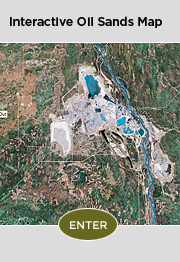Welcome
The Oil Sands Developers Group (OSDG) is a non-profit, industry-funded association, located in Fort McMurray, Alberta, Canada.
OSDG represents oil sands operators and developers, and works in co-operation with related industries, government, Aboriginal peoples, and other organizations active in the Athabasca oil sands region to define and address regional issues related to oil sands development, and to communicate accurate, credible information about Athabasca oil sands activity.
Ken Chapman, Executive Director
Ken is the Executive Director of the Oil Sands Developers Group. His focus is on helping to improve the quality of life in the Wood Buffalo region, ensuring proper environmental stewardship and responsible and sustainable oil sands development. He works to engage directly with public policy designers and decision makers in all orders of government, local stakeholders, a wide range of industry sectors, environmentalists, scienctists, Aborginal groups and community leaders.
He was a founder of Cambridge Strategies Inc., a public policy consultancy group prior to joining the OSDG in June 2011. As a lawyer he championed a number of key cases from legalizing midwifery to establishing French language education rights in Alberta. He is very interested and involved in social media, citizen engagement, and deliberative decocracy issues. He has an on-going and keen interest in the arts culture, creativity and innovation. He is recoginized as one of Alberta Ventures 50 Most Influential People in 2010 and received the Queen’s Golden Jubilee Medal for service to the community.
Some businesses we know
Dufferin Rogers Dental Clinic Family Dentist & Dental Implants
2032 Dufferin St, York, ON M6E 3R5
(416) 658-3384
Trinity Family Dental Clinic Whitby
185 Thickson Rd, Whitby, ON L1N 6T9
(905) 579-5551
TPI Personal Injury Lawyers
2800 Skymark Ave #503, Mississauga, ON L4W 5A6
(905) 361-1500
Uptown Yonge Dental
2717 Yonge St, Toronto, ON M4N 2H8
(416) 487-3333
Adelaide Barks Dog Daycare and Boarding
23550 Highbury Ave N, London, ON N0M 1P0
(519) 854-1214
Purple Bean Media Web Design, Social Media Management, Video Production, Search Engine Optimization (SEO)
446 Grey St Unit #302 B, Brantford, ON N3S 7L6
(226) 920-9850
Moto Kave - ebikes, e-Scooters, e-Motorcycles, Electric Scooters, ATVs and Dirt Bikes
6402 Hamlyn St, London, ON N6P 1P8
(519) 471-3618
Super Steam London Carpet & Air Duct Cleaning
1020 Hargrieve Rd #10, London, ON N6E 1P5
(519) 857-9444
Ike’s Asphalt Driveway Paving Company and Paving Contractor
4288 ON-3, Simcoe, ON N3Y 4K4
(519) 280-3122
Glenn D. Godfrey & Co. LLP Law Firm
3rd Floor, 35 Barrack Road, Belize City, Belize
+501 223-3530
Elev8 Aesthetic Medicine Inc. Botox Lip Fillers, Microneedling and PRP for Hair Loss
123 Pioneer Dr Building J, Unit #2, Kitchener, ON N2P 2A3
(519) 748-7284
Davidson's Jewellers
790 Bank St, Ottawa, ON K1S 3V6
(613) 234-4136
Easy House Loan Mortgage Broker
940 The East Mall Suite 202, Etobicoke, ON M9B 6J7
(647) 613-3279
Law Offices of Leonard F. Baer, PLLC - Elder Law Firm
1571 Bowery Rd, Highlands, NC 28741
1 828-371-0383
A to Z Storage, Self Storage Units, Boat & Car Storage
28607 Centre Rd, Strathroy, ON N7G 3H8
(519) 299-0179
Shamrock Pest Management
35 Walker St, Grand Bend, ON N0M 1T0
(289) 668-8062
Forest City Bounce & Party Rentals - Bouncy Castle and Party Inflatable Rentals
1020 Hargrieve Rd #10, London, ON N6E 1P5
(519) 200-0402
ProXpedite Inc. Commercial Kitchen Installations
4226 Raney Crescent, London, ON N6L 1C3
877-776-9123
Cannect Home Equity Loans
1006 King St W, Toronto, ON M6K 3N2
(416) 214-9000
Cannect Home Financing Mortgage Broker
81 Navy Wharf Ct, Toronto, ON M5V 3S3
(416) 766-2666
Cannect Private Mortgages & Small Business Loans
33 Gladstone Ave, Toronto, ON M6J 3K7
(416) 766-2666
TNL Waste Bin Rental
669 Governors Rd E, Paris, ON N3L 3E1
(519) 717-0030
Atlantis Pools & Spas
23550 Highbury Ave N, London, ON N0M 1P0
(519) 471-2058
Cremation & Celebrations London
21574 Richmond St, Arva, ON N0M 1C0
(519) 963-4003
Savarino Brothers Garden Center
24670 Broadway Ave, Oakwood, OH 44146
(440) 439-5358
The Home Depot
359 Main Street Thunder Bay, ON P7B 5L6
(807) 624-1100
Google Madison
811 E Washington Ave, Madison, WI 53703, United States
608-669-9841
Amazon Canada
1882 118 Ave NE, Calgary, AB T3K 0R1
Embodied Resilience Counselling and Consulting, Adult ADHD, BIPOC & C-PTSD Therapist
Mogenson Centre, 100 Collip Cir, Suite 115, London ON N6G 4X8
(416) 432-3070
IGV Website Design & Marketing
341 Talbot St Suite 319, London, ON N6A 2R5
(226) 546-0015
Dezan Social Media Agency
1470 Dundas St, London, ON N5W 3B9
(226) 926-6332
Advantage Vinyl - Fleet Graphics, Semi Truck, Trailer Advertising Wraps, Graphics, Business Signage, Printed Decals
130 Copernicus Blvd, Brantford, ON N3P 1L9
(519) 758-0439
Coach John
Beechwood Pl, London, ON N6C 1H7
(519) 671-5947
Jova Medical Aesthetics and Bare Laser & Skin
1067 Valetta St Suite 101, London, ON
(519) 870-5682
Vakili Psychological Services, ADHD Therapist
1550 8 St SW #501, Calgary, AB T2R 1K1
403) 836-1967





















